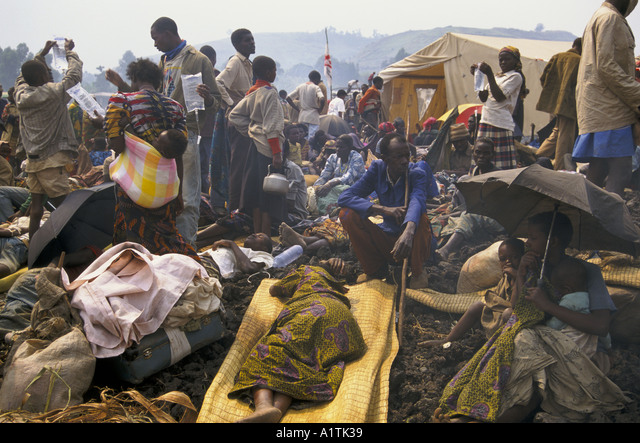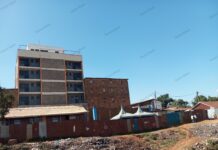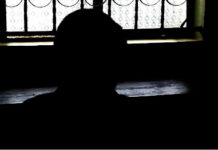By Omboki Monayo
Goma, DR Congo: A sprawling expanse of makeshift shelters dots the outskirts of Goma. From a distance, one would be forgiven for mistaking the large settlement for a carnival ground. Almost as far as the eyes can see are temporary dwellings made of cardboard, gunny bags, nylon sacks, ripped khaki tents, and tarpaulin strips.
Their ungainly walls are fluttering, anchored to stakes by bits of rope and string in the wake of a wind blowing through the camp.
Mothers with babies strapped to their backs gingerly make their way through the rows of houses to queue up for rations at the MSF trucks parked at the edge of the settlement.
A humanitarian disaster is underway in North Kivu, in the east of the Democratic Republic of Congo (DRC). From the relative calm in the glare of the afternoon sun, one could be forgiven for thinking the refugee camp always existed.
It is to this region that around one million people have fled their homes in the past 12 months to escape fighting linked to the resurgence of the M23 armed group.
In late 2021, the March 23 movement (M23), a Congolese Tutsi-dominated rebellion – known to have occupied Goma, the provincial capital of North Kivu since 2012, took up arms against the Congolese army, constantly gaining ground in the province in the course of 2022. Violent armed clashes, linked to the resurgence of this armed group, have forced an estimated one million people to flee their homes since March 2022.
The massive humanitarian crisis continues to worsen an already critical humanitarian situation in the province, where 2.5 million people are thought to be displaced. Displaced people, as well as people living in remote communities cut off by the fighting, are exposed to numerous health risks. Yet, this severe deterioration of the situation did not trigger a rapid and massive humanitarian response.

A glimmer of hope beckons for refugees in some of the affected areas. In parts of Goma, the M23 rebels have been pushed out of most infrastructure corridors thanks to the presence of the East African peacekeeping contingent.
According to Major General Jeff Nyaga of the East Africa Community Regional Force (EACRF), the December 2022 withdrawal was achieved without firing a single shot.
“We have managed to secure the vital infrastructure corridors in the region and restored calm to most areas,” the peacekeeping boss said in an interview with Citizen TV’s Seth Olale on April 19, 2023.
At the end of March 2023, the peacekeeping force mandate dubbed The Status of Force Agreement (SOFA), which provided for the EACRF deployment, formally expired, birthing new fears of a resurgence in hostilities should the troops be withdrawn from the area.
In a move that signals a commitment to maintaining the relative calm in the area, the Democratic Republic of Congo has agreed to retain the EACRF on its territory, even though the actual terms for the mission will be re-negotiated.
The development comes after a Bujumbura meeting between representatives of the East African Community partners and their Chiefs of Defence Forces to review the six-month performance of the EACRF. Even within the uneasy calm of the informal displacement sites around Goma, another sinister and ruthless foe lurks.
Poor living conditions expose vulnerable refugees to the ever-present risk of disease.
The combination of inadequate and overcrowded shelters coupled with a lack of clean water and proper latrines is a potent cauldron for the breakout and spread of diseases.
Within the campgrounds, one will occasionally bump into the sight and smell of human waste. Houseflies and other insects buzz freely all over the settlements, multiplying the risks of diarrhoeal diseases and other ailments spreading among the refugees.
The disease is now adding misery to the war-weary escapees from conflict, adding to the toll of suffering and death that stalks the camps. Inadequate and overcrowded shelters coupled with a lack of clean water and latrines continue to put hundreds of thousands at risk of diseases and outbreaks in the outskirts of Goma, with cholera and measles that broke out in several sites already.
Over the past few months, measles and cholera broke out in sites north of Goma, in Nyiragongo territory. With cases of suspected measles and cholera multiplying over the past few weeks, the health situation has now become critical in Bulengo and Lushagala.
MSF teams have been working in informal displacement sites around Goma since May 2022, providing free medical care, trucking in supplies of drinking water, and constructing latrines and showers.
Its teams are also seeing the consequences of the crisis in areas north of Goma like Masisi, Rutshuru, and Lubero territories.
“Throughout the year, MSF teams have constantly increased their efforts, adapting their response to the needs of the displaced people, while ensuring continuous access to healthcare in our regular projects in North Kivu. Amidst this deep deterioration of the situation in North Kivu, the current humanitarian response is still vastly inadequate,” reads the MSF press release on the crisis.
Many medical facilities have run out of drugs due to supply problems. Accessing healthcare in these territories was already difficult but is now even more challenging due to the lack of functioning health facilities.
The cost of medical care is also beyond reach for many in the current economic crisis.
According to MSF, the struggle to contain the refugee population is rapidly becoming a losing struggle due to the sheer numbers of those in need. “But the needs are exceeding by far our team’s capacities alone, who are completely overwhelmed,” says the humanitarian organization.
All those involved in the humanitarian response must be more reactive and more flexible in order to respond quickly to people’s needs and adjust to changing population movements. MSF is calling on the international community and the authorities to urgently scale up their efforts to meet people’s needs.
“However, much remains to be done. And as the fighting continues, yet more people may be forced from their homes and require aid to survive, not only in Goma,” says the press release. North of Goma, MSF teams are also seeing the consequences of the crisis in Masisi, Rutshuru, and Lubero territories.
As the frontlines of the fighting have shifted, most of the major routes into the region have been cut off. Transport links into this agricultural region, known as “the granaries of the province”, are essential for trade in North Kivu.
Cut off from the rest of the province, inhabitants have been unable to sell their crops or buy all but a few essential products, which have doubled in price. Many medical facilities have run out of drugs due to supply problems. In these territories, accessing healthcare was already difficult but is now even more challenging due to the lack of functioning health facilities and to the cost of medical care, which is unaffordable for many in the current economic crisis.
As prices rise and access to healthcare deteriorates, food insecurity is fast becoming a luxury for many in the province. More than one-third of North Kivu’s population or an estimated three million people are currently at risk of food insecurity, according to the UN.
While decrying a current vastly inadequate humanitarian response, MSF is calling on the international community and the authorities to urgently scale up their efforts to meet people’s needs.
“In the face of the scale of the crisis, our teams are completely overwhelmed,” says the MSF. “MSF is concerned by the vastly inadequate humanitarian response in the face of this humanitarian disaster and has issued an urgent call for increased efforts from the international community and the authorities,” the humanitarian organization’s document reads.













